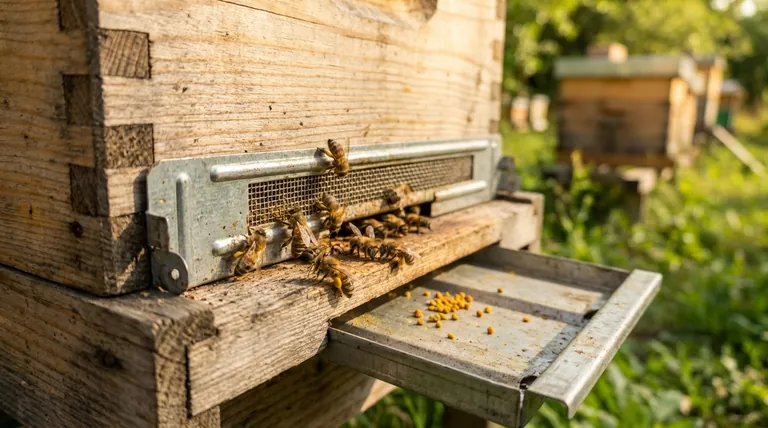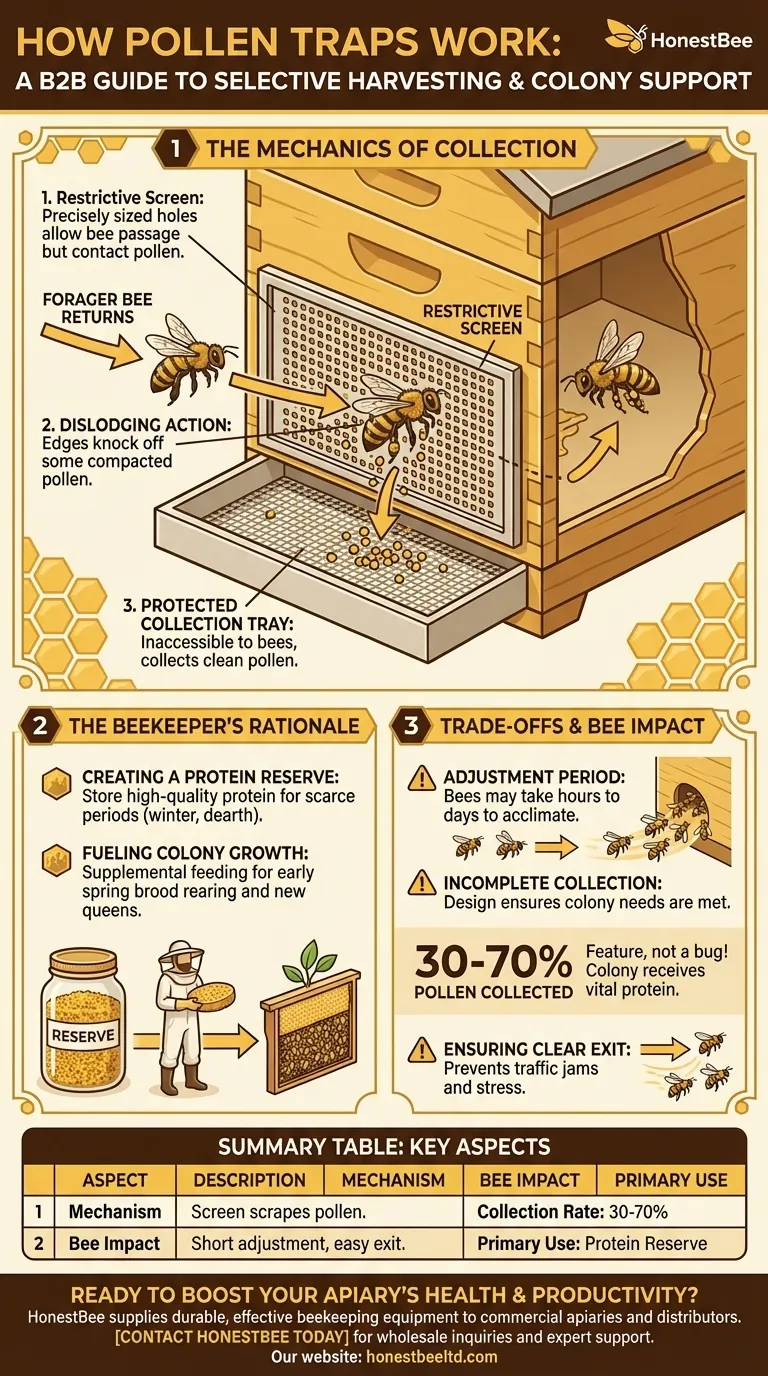At its core, a bee pollen trap is a simple, mechanical gatekeeper for the hive. It works by placing a screen with small holes over the hive entrance. As returning forager bees squeeze through these openings, the screen gently scrapes a portion of the pollen pellets from their legs, causing them to fall into a protected collection tray below.
The crucial insight is that a pollen trap is a selective harvesting tool, not a total barrier. It is intentionally designed to collect only a fraction of incoming pollen, ensuring the colony still receives the vital protein it needs to raise its young and thrive.

The Mechanics of Pollen Collection
A pollen trap's effectiveness comes from its simple yet clever physical design. It manipulates the bee's natural entry process without fundamentally harming the insect or halting its work.
The Restrictive Screen
The primary component is a wire mesh or a plate with precisely sized holes. These openings are large enough for a bee to pass through but small enough to make contact with the pollen baskets on its hind legs.
The Dislodging Action
As a returning forager pushes through one of these holes, the edges of the opening knock off some of the compacted pollen pellets. This action mimics what might naturally happen if a bee brushed against a branch or leaf.
The Protected Collection Tray
The dislodged pollen pellets fall through a screen into a drawer or tray. This tray is inaccessible to the bees, which keeps the collected pollen clean and prevents them from retrieving it.
The Beekeeper's Rationale
Collecting pollen is not merely for human consumption; it is a critical apiary management technique used to support colony health and growth throughout the year.
Creating a Protein Reserve
The primary reason beekeepers collect pollen is to create a reserve of high-quality protein. This stored pollen can be fed back to colonies during periods when natural pollen is scarce, such as late winter or during a summer dearth.
Fueling Colony Growth
This supplemental feeding is especially vital for early spring brood rearing or raising new queens. By providing a pollen substitute, often mixed with soy flour or brewer's yeast to create pollen patties, a beekeeper can stimulate colony growth before natural sources are abundant.
The Post-Harvest Process
Once collected from the trap, the raw pollen must be processed. This typically involves cleaning the pollen to remove any hive debris, followed by freezing it immediately to preserve its freshness and nutritional value.
Understanding the Trade-offs and Bee Impact
While effective, using a pollen trap requires careful consideration of the colony's well-being. It is an intervention that changes the bees' daily routine.
A Period of Adjustment
Bees may take a few hours to several days to become accustomed to the new entrance. Initially, you may see them congregating at the front of the hive, searching for a way around the trap, but they eventually learn to navigate it.
Incomplete Collection is by Design
A well-designed trap will only collect between 30% and 70% of incoming pollen pellets. This inefficiency is a feature, not a bug, as it guarantees the colony's foragers can still deliver enough pollen to feed the developing brood.
Ensuring a Clear Exit
It is critical that the trap does not hinder bees from leaving the hive. If bees cannot exit easily, it can cause traffic jams, increase stress, and discourage foraging altogether. Most modern traps are designed to allow for easy exits.
Making the Right Choice for Your Goal
The decision to use a pollen trap should be aligned with your specific beekeeping objectives.
- If your primary focus is boosting colony health: Use a trap for short periods during a strong pollen flow to build a reserve for feeding your own bees back in early spring.
- If your primary focus is harvesting pollen for sale: You must carefully monitor hive strength and only use traps on your strongest colonies, ensuring the design allows sufficient pollen to pass through for brood rearing.
- If you are a new beekeeper: Focus on mastering basic hive management before introducing a pollen trap, as it adds a layer of complexity and potential stress to the colony.
Ultimately, a pollen trap is a tool that allows a beekeeper to borrow a valuable resource from the hive with the promise of paying it back when the bees need it most.
Summary Table:
| Key Aspect | Description |
|---|---|
| Mechanism | A screen with small holes scrapes pollen pellets from forager bees' legs as they enter the hive. |
| Collection Rate | Well-designed traps collect 30-70% of incoming pollen, ensuring the colony's needs are met. |
| Primary Use | To create a protein reserve for supplemental feeding during periods of natural pollen scarcity. |
| Bee Impact | Bees require a short adjustment period; a good design allows for easy exit to prevent stress. |
Ready to Boost Your Apiary's Health and Productivity?
As a beekeeper, you understand the importance of high-quality equipment for sustainable hive management. HONESTBEE supplies durable, effective beekeeping supplies and equipment to commercial apiaries and beekeeping equipment distributors through our wholesale-focused operations.
Whether you're looking to implement pollen trapping for colony health or scale your operations, our products are designed for professional results. Let's discuss how we can support your business.
Contact HONESTBEE today for wholesale inquiries and expert support.
Visual Guide

Related Products
- HONESTBEE Advanced Ergonomic Stainless Steel Hive Tool for Beekeeping
- Professional Dual-End Stainless Steel Hive Tool for Beekeeping
- Professional 3-Bar Frame Grip with Integrated Hive Tool
- Full Set Beekeeping Electronic Bee Venom Collector Machine Device for Bee Venom Collecting
- Metal Bee Hive Stand Bee Box Stand for Beekeeping
People Also Ask
- What are some common uses of a hive tool? Essential Multi-Purpose Tool for Every Beekeeper
- How is a hive tool used for scraping and cleaning? Master Hive Maintenance for a Healthy Colony
- How should beekeepers handle bees when using a hive tool? Master Calm, Deliberate Techniques
- What tools are used for cleaning frames? A Beekeeper's Simple 4-Tool Guide
- What is the hole in a hive tool for? A Multi-Tool for Apiary Repairs and Maintenance



















